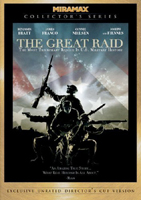 BUY IT AT AMAZON: CLICK HERE!
BUY IT AT AMAZON: CLICK HERE!
STUDIO: Miramax
MSRP: $39.99
RATED: Unrated
RUNNING TIME: 131 min.
SPECIAL FEATURES:
Disc 1
• Commentary by Director John Dahl, Producer Marty Katz, Military Advisor Dale Dye, Editor Scott Chestnut and Author Hampton Sides
• The Price of Freedom: Making The Great Raid
• Extended Deleted Scenes with Commentary
Disc 2
• ‘The Ghosts of Bataan’ documentary
• The Veterans Remember
• History Lesson with Hampton Sides
• Captain Dale Dye’s Boot Camp
• Boot Camp Outtakes
• Mixing The Great Raid
• Mix Board with Special Audio Options
• War in the Pacific Interactive Timeline
• Dedication to the Soldiers of Bataan
January, 1945. Japan was slowly but surely losing the Pacific war. In the Philippines, over 500 American POWs, survivors of Bataan and Corregidor, clung to life in the Cabanatuan prison camp. Amid concern that the Japanese would soon decide to exterminate the prisoners, Lt. Col Henry Mucci and tactician Captain Bob Prince were tapped to mobilize the underused 6th Ranger Battalion in Calasio for a daring mission: go behind enemy lines, hike 30 miles through the jungle, coordinate with Filipino allies, then literally crawl the last half-mile right up to the gates of the camp itself, shoot their way in, and evacuate their brothers-in-arms.

"Yeah, they beat on me with a baseball bat. So what?"
The Flick
What’s this? An unironic, old-fashioned war movie? No political subtext, no tortured dissection of the myths of heroism and nationalism? Pretty much, except the cast is largely lacking in old-school charisma; there’s not a Coburn, a Marvin, a McQueen, even a Garner to be found. Benjamin Bratt (as Mucci) and James Franco (as Prince) are solid, and Xena veteran Marton Csokas scores as one of the prisoners, but poor Joseph Fiennes gets stuck playing an obvious echo of his brother’s English Patient role. Connie Nielsen, as underground resistance figure Margaret Utinsky, appears to be starring in brief excerpts from a different film.
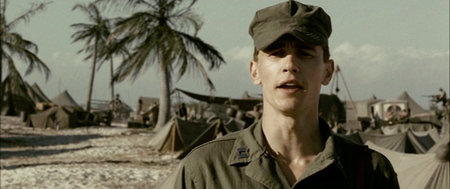
"Which way to Annapolis?"
Documented history can be a bitch. How do you construct a proper Hollywood narrative with highs, lows, challenges and reversals when the actual event was almost a complete success? If you’re the original screenwriters on this project, you make shit up. You invent a love story, you sprinkle action highlights here and there, you kill off a major character right before Act 3.
To his credit, John Dahl (a war-movie neophyte, but no stranger to CHUD fans) has reined the story back towards the essential facts. He’s still stuck with a flawed screenplay: the love story between Nielsen’s historical character and Fiennes’ fictional one remains, and is probably the single biggest obstacle to presenting a coherent story. Some more detail on Captain Pajota (Cesar Montano) and the Filipino guerillas would have been nice; a feature film dedicated to their tale alone, even better.
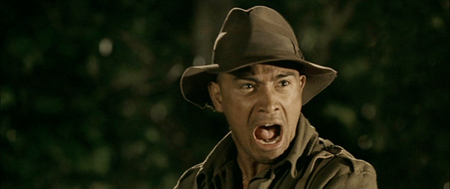
"Are we there yet?"
If the film has one genuine failure it’s in establishing the geography of the events. I never had a solid idea of the terrain Mucci’s men had to traverse, or how far the camp was from either Cabanatuan City or Manila. Sometimes you need the old red-line-on-a-map, corny as it is: at least the raid itself is efficiently laid out beforehand.
Said raid is a terrific, manly action sequence full of guns, grenades, mortars, bayonets, even a tank. If you didn’t appreciate what Jarhead was trying to say about ‘pink mist’ you’ll be happy to find plenty of it here.

"Aaaa-CHOO!"
Ultimately, while The Great Raid succeeds as a supplement to historical record, it fails as a film. There’s no suspense or urgency to the story (the fact that, at the time, Japanese troops were actively approaching from the south goes curiously unaddressed), and Ms. Untinsky’s story never dovetails satisfactorily with that of the rangers or the prisoners.
6 out of 10

"Burn ward, eh? Good tippers."
The Look
16:9 anamorphic transfer, letterboxed to 2.40:1. The entire movie is bathed in desaturated yellows for that ‘flashback’ feel, so it’s hard to tell what the correct color values are supposed to be.
Special praise should go to the presentation of the archival footage that bookends the film. It’s cropped to fit the ‘scope frame, but it’s remarkably clean given its age and there’s stuff of the actual raiding party that you’ve probably never seen. Also, it reveals Bratt as a ringer for the real-life Mucci.
7 out of 10
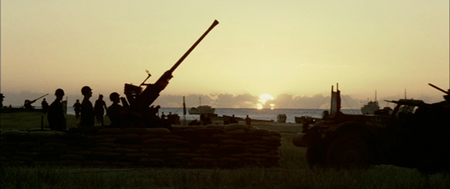
"Now you’ve done it. You shot down the sun."
The Noise
Dolby 5.1. Activity is mostly limited to atmospherics. Dialogue is sometimes hard to make out since a lot of it is whispering. There are some superb directional effects in the raid sequence.
8 out of 10
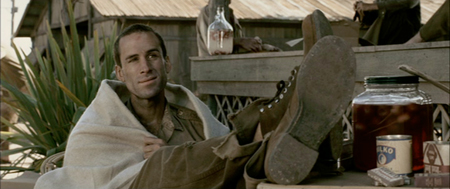
"Dear Gwyneth. Write if you get work. Love, Joe."
The Goodies
The commentary track focuses on historical context and detail. There is much talk regarding the film’s depiction of the Japanese, who by all accounts were uncommonly brutal to prisoners and civilians alike. Many rationales for their behavior are presented, none entirely satisfactory. Certainly, the film itself makes no investigation of their psychology.
This track also reveals one of the dangers of having the filmmakers comment on their movie without watching it in real time: a recurring anecdote involves the struggle to acquire, and failing that, to construct, a Sherman tank for the film’s emotional climax. Don’t blame yourself if you missed it—it’s not in the final cut!
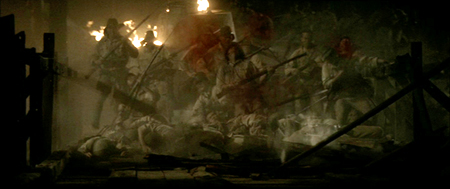
Operation Human Shield has predictable results
There are about 25 minutes of deleted scenes, many of them fabricated action beats, with optional commentary from Dahl. I would like to have had some indication of which material (if any) was featured in the theatrical-release cut of the film (available in 1.33:1 fullscreen only, HERE). The afore-mentioned Sherman tank finally shows up at the end.
Disc 2 is largely given over to pure history. If you’re unfamiliar with the true events behind the movie, like I was, you may want to watch this first. The Interactive Timeline is well-designed and well-researched, but its accompanying text tends toward bias and melodrama.

Sorry, this is just a picture of my old apartment.
The sound-mixing workshop allows you to play separate tracks from the raid sequence (you can’t actually mix them, though), and there’s a brief documentary about the boot-camp training the actors underwent to prepare for the film.
8 out of 10
The Artwork
Know what this looks like? Charlie’s Angels, but with dudes. That soldier on top better stop admiring his rifle and get his ass down before it gets shot off. An image of the rangers crawling towards the camp would have been much more effective in letting us know which war movie this is.

4 out of 10